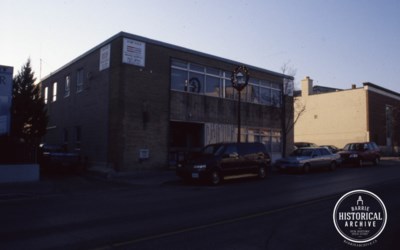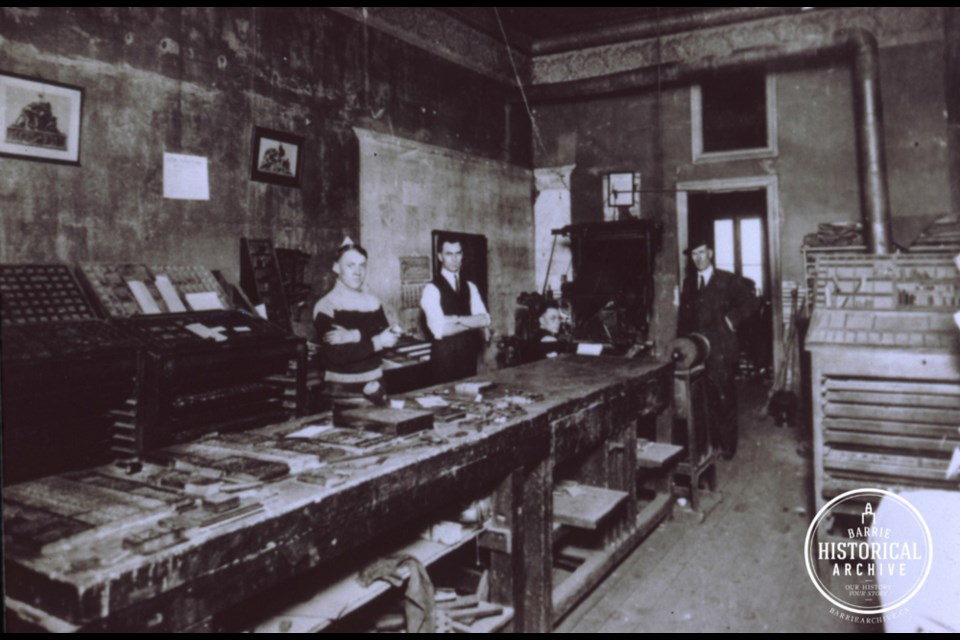On a street four decades older than Canada, just below the historic Five Points intersection, sits a building living a second life on a site that has seen a lot of changes.
Sixteen Bayfield St. could tell a lot of stories. In fact, it has told many in its 40 years as the Barrie Examiner building.
The Examiner had been printing a weekly paper for many years, near the corner of Mulcaster and Dunlop Streets, just about where Robert Stephen’s men’s wear shop operated for numerous decades before it recently vacated. A fire in August of 1914 destroyed or heavily damaged the three buildings west from the corner, forcing the Examiner to move in with a competitor, the Saturday Morning paper, and do business out their basement rooms in the Ross Block.
The rivals soon merged into one paper, then proceeded to purchase their main opposition, the Northern Advance. The Barrie Examiner continued to steadily grow and added a second weekly printing by 1948, and took a step into the commercial printing field at the same time. Somehow, they managed all of this out of their Dunlop Street shop.
When the Thomson Corporation bought the Barrie Examiner in 1957, they were swift to want to modernize. The Feb. 17, 1958 edition of the Examiner introduced their plans for a new state of the art printing plant to be built on Bayfield Street, just south of the Bank of Nova Scotia building, now Mady Theatre. Two small structures would be demolished and the plant would run almost an entire block back to Maple Street.
One of the small older buildings was the first Brewers’ Warehouse in Barrie. After Prohibition ended in 1927, beer was first sold legally again in Barrie from this outlet. In 1957, they also outgrew their premises and relocated to Anne Street where the Beer Store remains today.
Next door was a former movie theatre, one of the locations of the Dreamland Theatre, which had existed in Barrie before the Great War. The Beatty family operated it then sold it to the Sasos, who sold it again when they opened the Roxy Theatre in 1931.
The vacant theatre became one of the many locations of A.J. Tuck’s questionable junk shops. The local papers are filled with accounts of Mr. Tuck’s failed health inspections, missing business licences, theft accusations and other shady dealings.
Previous to even these ventures, the site is described on a 1907 map as a livery stable. Basically, a boarding house for horses, a livery stable would have been an important service for businessmen in the early days of commuting to work in Downtown Barrie. It would also have served as a place to keep a horse if your home was without a barn, such as dwellings above the shops.
All of that came to an end when the heavy machinery removed all traces of the old and the 16 Bayfield St. structure that you see today began to rise. When complete, the east-facing front section, as well as the second floor, contained offices. The middle section housed the presses and the far west was for distribution.
 The empty 'Examiner' building before being purchased by the Salvation Army. 1999
The empty 'Examiner' building before being purchased by the Salvation Army. 1999I likely visited most frequently in the 1990s, as each of my children arrived, when I dropped in to place a birth announcement in the paper. By 1999, the Examiner headed north to 571 Bayfield St., home of the former Beaver Lumber, to expand once more.
When one business grows out of their space, another entity is becoming cramped in theirs and is on the hunt for a bigger home. So it was with the Salvation Army, who had been serving the poor in Barrie for almost as many years as the Examiner had been printing in the community. In the last decades of the 20th Century, the Salvation Army had been operating a large thrift shop and a shelter just north of the Five Points. In 1988, a regular soup kitchen was started.
As any population expands in numbers, so does each segment of society, from rich to less fortunate. The Salvation Army began thinking of looking for a place where they could better serve their community and found it in the nearby former Examiner building.
Today, 16 Bayfield St. is under the umbrella of the Salvation Army Bayside Mission which is three services in one – Family Services, which offers various social work programs for families and individuals; community kitchen, formerly a soup kitchen; and a men’s shelter.
The front offices are still offices today, but the press room now contains a well laid-out commercial kitchen and a 56-seat dining room that serves 90,000 free meals a year. The distribution area was for years a thrift shop but now houses meeting space, a computer lab, a teaching kitchen and more. Up to 36 men sleep, shower and do their laundry on the second floor each night.
Unlike most of the other fine buildings I have written about this year, I did not have to ask for a special tour of this one. I proudly call the Salvation Army Bayside Mission community kitchen my workplace.



